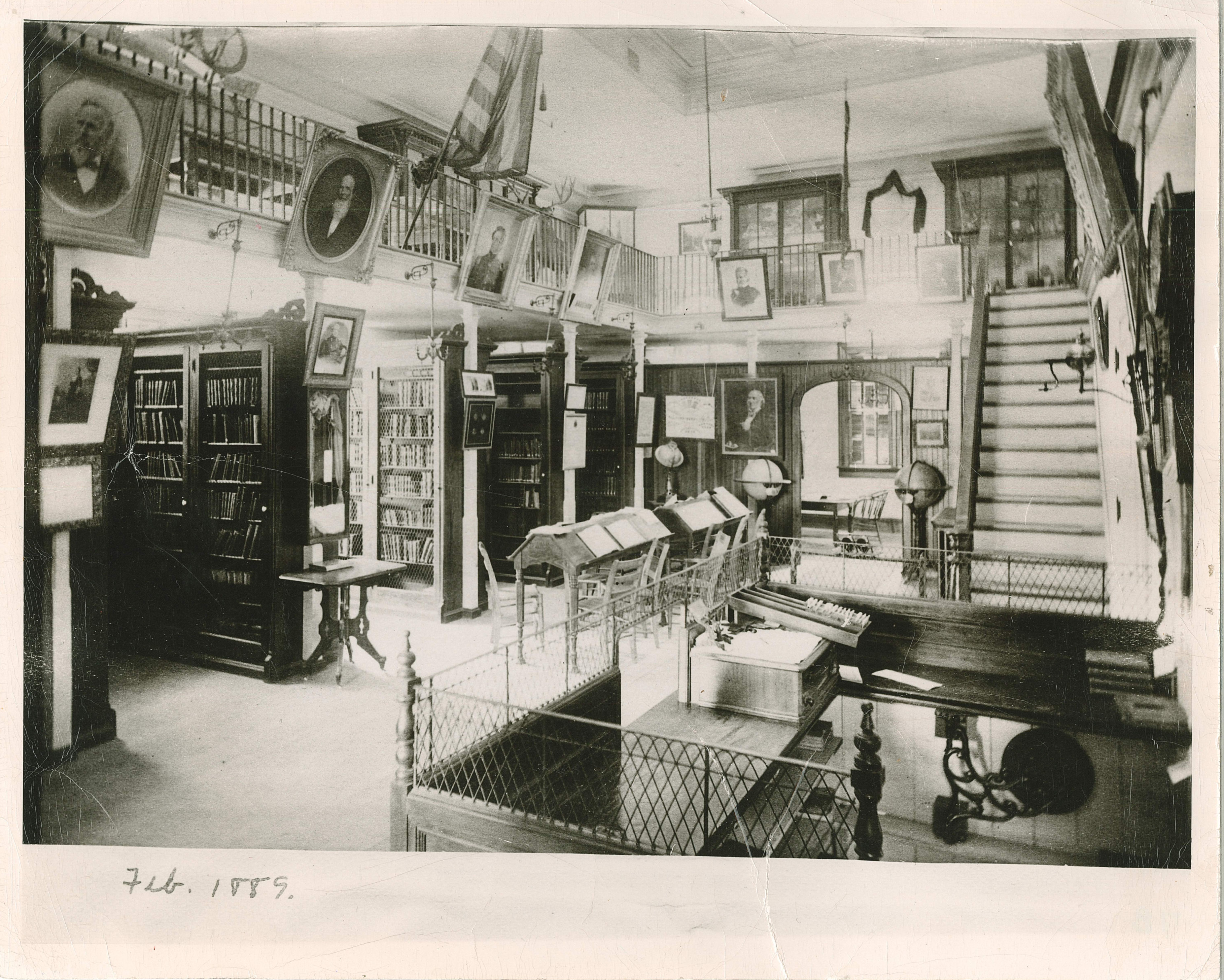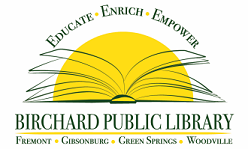“Sardis Birchard has conveyed real estate and other property to the value of $50,000 in trust to establish in Fremont a Library…for the free use and benefit to the people of Sandusky County.” With these words, Rutherford B. Hayes announced his uncle’s generous bequest to the City Council in July of 1873. President Hayes not only gave the money, but also supervised the founding of the library and served as chairman of the Board of Trustees until his death.
On June 3, 1874, Birchard Library opened its doors to the public in a building on Front Street. Containing 1,683 volumes of the 5,000 books ordered by Hayes, patrons could borrow books only if they were 14 years or older and deposited a bond or $3.00. Only librarians could remove books from the shelves.
In 1878 a library building was erected at a cost of $6,369.31 on the site of Fort Stephenson, a stipulation of the original bequest. By the early 1900’s, thanks to a $2,500 gift of from Mrs. Elizabeth Kelly, the Kelly Reading Room was added to the structure.

Several notable people served the library during the first fifty years. Mrs. Harriet A. Gast served as library director from 1879 to 1915 for a salary ranging from $350 to $500 per year. Funding was a major obstacle during this time but Mrs. Gast kept the library open, even taking a $100 pay cut at one point.
In the early days the library was funded by the Birchard bequest with assistance from the town. In 1904 a crisis arose when the Fremont city council threatened to cut off the heat in an economy move. When library trustees, led by Colonel William E. Haynes, visited City Council to protest, they returned with a gift of $1500 and the promise of a half mill tax levy. This became the first move toward placing the library on a public support basis.
Another notable person in the development of the library was Lucy Keeler, cousin of President Hayes, who became Secretary of the Board of Trustees in 1915. Although she never held a paid position, she succeeded in making many changes. Under her leadership the library changed from being privately endowed to being partially supported by local taxes. Internally, she initiated the adoption of new library methods, and then she carried on an extensive publicity campaign to bring the library to the people.
From 1923 to 1944 there were a number of significant changes. In 1935 a stable source of funding was found in the intangibles property tax. Birchard Library began to extend its services throughout the county with branches in Gibsonburg (1936) and Woodville (1937). Mrs. R.D. McAllister was hired in 1936 to provide county extension service. Her husband drove her to the stops in their station wagon until 1938 when the library purchased a panel truck for the purpose of transporting books. In 1940 an addition was made to the library.
In 1944 Mrs. Hallie M. Grimes was hired and she presided over a period of rapid growth and development. Under her leadership the first bookmobile was purchased in 1949 to provide service to school and county stops, and in 1956 a bookmobile garage was added. In 1965 she achieved the long time dream of previous librarians by adding a children’s room and an additional room above the bookmobile garage. The library changed its status from association library to county district library in 1968 and in 1969 Green Springs Memorial Library became a branch of Birchard when the Clyde and Green Springs school districts merged.
Since 1971, Birchard Library has been served by library directors Richard Gooch (1972-1982), Mary Anne Culbertson (1982 -2009) and Pam Hoesman (2009 to the present). These years have seen major changes in the library and its array of services.
By the early 1980’s it was apparent that the collection had outgrown the building. After significant weeding and an inventory of the collection, work was begun on a building plan. Plans were developed to double the size of the main library building, restore some of the architectural elements that had been lost in previous renovations, and remodel the existing structure to make it suitable for the wiring requirements of computers. The resulting building was an elegant design which provided much needed space while retaining the original style and showcasing a traditional but functional interior.
To fund this expansion, provide improvements for the branches and purchase an automated circulation system, the trustees placed a successful $3,600,000 bond issue on the ballot in May of 1987. In early 1988 the main library moved to temporary quarters in a former car dealership as work commenced. At the same time, the Green Springs and Woodville branch buildings were renovated and the debt was paid on the Gibsonburg building. The community was justifiably proud of its beautifully remodeled main library facility dedicated in October of 1989.
The public responded to the new facility and improved services by increasing their use of the library. From 1982 to 1990 circulation doubled. Fortunately, in 1986 funding for the library changed from the intangibles tax to a dedicated portion of the state income tax which allowed the library to increase services. In 1991 the library discontinued bookmobile service as school libraries had improved. Instead, the library Outreach Department began to offer extensive library services to nursing homes and nursery schools. In 1992 the library joined the information age when the card catalog was automated. In 1994 Gibsonburg branch library was expanded to include a children’s wing, thanks to a $300,000 bequest by Elizabeth Scherger. In 2002 the Green Springs branch library building was demolished and rebuilt thanks to funding by the library system, Don Miller, Jeanne Reed, the Birchard Library Association Foundation, and the Claude Young family.
In the closing years of the century, computers and Internet access created a major technological shift in libraries. In 1996 the Ohio Legislature created and funded the Ohio Public Library Information Network to provide free Internet access at the public library for all Ohio citizens. Information from all over the world became accessible to our citizens through computers available at each of our four library locations.
Since January 1, 2000, library participation in the Clevnet library system has given patrons access to over 3 million titles and increased online services. In 2007 funding for Ohio public libraries was changed to a percentage of state general revenue.
Recently, Birchard Public Library conducted a survey and focus groups to ascertain what community members expect from their public library. In response to this survey, the library has planned an 8,500 square foot addition to the main library which will provide space for vital community services. See building plans for details.
We have come a long way from requiring a deposit and handing books to patrons; Birchard Library now freely provides information from around the world in a variety of formats in person at each facility and online to everyone. President Hayes and Sardis Birchard would be astonished at the fulfillment of their dream.
